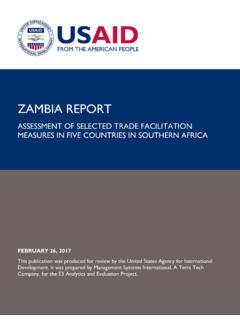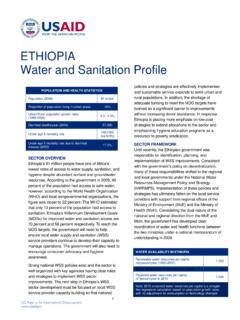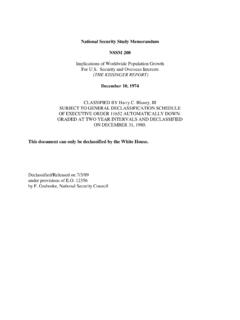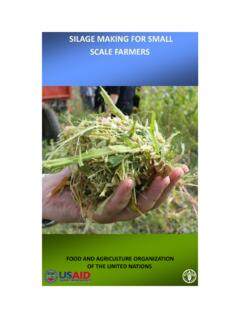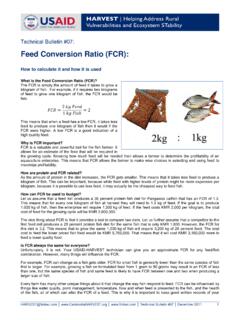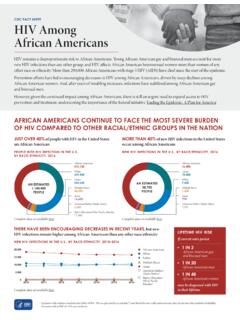Transcription of HIV/AIDS Health Profile: Sub-Saharan Africa
1 + Sub-Saharan Africa Overall HIV Trends Sub-Saharan Africa continues to bear an inordinate share of the global HIV burden , though epidemics across countries in Africa vary considerably: million people living with HIV/AIDS (PLWHA) live in the region, representing about 68 percent of the total worldwide. The number of new infections in Sub-Saharan Africa peaked by 1997 and has fallen by 26 percent since then from million to million per year1. In 22 countries, models indicated a decline in the incidence of HIV infection by 25 percent, including those in some of the countries with the largest epidemics: Ethiopia, Nigeria, Zambia, and Zimbabwe.
2 The epidemic continues to be a major challenge to the Health and development of many African nations. As antiretroviral therapy (ART) becomes more widely available, more people than ever will be living with HIV. South Africa has more PLWHA ( million) than any other country in the world. Prevalence estimates throughout the continent range from percent in Madagascar to over 25 percent in Swaziland. Deaths from HIV continue to decline as ART coverage and prevention of mother-to-child transmission of HIV (PMTCT) coverage increase. The impact of HIV varies considerably throughout the countries in the region, and most have generalized epidemics.
3 Adult prevalence exceeds 20 percent in countries, including Botswana ( percent), Lesotho ( percent), and Swaziland ( percent)2. Others have concentrated epidemics with disease hotspots, such as Burundi, where prevalence of 38 percent among sex workers is 16 times higher than general adult HIV prevalence2, and throughout West Africa , where general prevalence is markedly lower than in East and Southern Africa , but epidemics among most-at-risk populations (MARPs) are common. Due to this variation, the strategic approaches to combat this disease must be designed to respond to the disease characteristics within individual countries and subregions.
4 Country Specific Epidemics. Sub-Saharan Africa has a heterogeneous epidemic with distinct patterns in the three different regions. In Southern Africa , prevalence has stabilized at high levels in most countries; prevalence has also declined since 2000 in most East African countries and is now stabilizing at markedly lower levels than in Southern Africa . In West Africa , prevalence rates are markedly lower than in the rest of the Africa region, at less than 2 percent across the region except in Cameroon ( percent), Cote d Ivoire ( percent), Gabon ( percent), and Nigeria ( percent)2.
5 Within countries, there is also a great deal of regional variation, with urban centers often the most affected. Across all three regions, heterosexual sex is the primary form of transmission, though in countries with more concentrated epidemics, high-risk behaviors can play a significant role, including sex work and men having sex with men2. Southern Africa . Southern Africa continues to be the most severely affected region in the world. The number of people living with HIV increased by 31 percent from million a decade earlier to million people in 2009. According to recent estimates, 40 percent of all HIV-positive women globally live in 10 countries in Southern Africa3.
6 From a global perspective, an estimated 31 percent of people newly infected with HIV and 34 percent of people dying from AIDS-related causes lived in these 10 countries. Swaziland has the highest prevalence of any country in the world: Approximately one in every four adults is HIV-positive. Prevalence rates in most countries in the region have stabilized, though Zimbabwe is the first country in Southern Africa to sustain a significant decline 1 in HIV prevalence from 29 percent in 1997 to 16 percent in 20071. Compared with other countries in the subregion, Angola has a remarkably low HIV prevalence (2 percent), in part due to the limited movement during its protracted civil war (1975 2002), which impeded the spread of the virus.
7 Across the region, the epidemic affects individuals in all levels of society, across education, income, and migration strata. Scale-up of prevention programs is necessary to generate continued declines in HIV prevalence and incidence. East Africa . In the countries of East Africa , HIV prevalence began declining about a decade ago and has remained stable in many countries. In this region, the intensity of national epidemics varies from country to country, and heterosexual sex is the primary form of transmission. Those who are married or in a committed relationship can still be at an elevated risk if their partners engage in high-risk behaviors.
8 The HIV prevalence in Kenya fell from 14 percent in the 1990s to 6 percent in 2006 and has stabilized at that rate since 2006. Uganda s prevalence has remained between 6 percent and 7 percent. Similarly, in Rwanda, HIV prevalence has remained the same4,5; however, the HIV prevalence in Rwanda is over three times higher in urban areas than rural areas. Prevalence in Kenya, Tanzania, and Uganda exceeds 5 percent ( percent, percent, and percent, respectively)2. Geographic variation within countries is common; for example, prevalence varies as much as 15-fold across different provinces in Kenya6.
9 Madagascar has been one of the lowest prevalence countries in East Africa , with an adult prevalence of percent, while the limited availability of HIV-related data in the Democratic Republicof the Congo makes it difficult to fully characterize the epidemic there. West Africa . The countries of West Africa have the lowest HIV prevalence in Sub-Saharan Africa . Adult HIV prevalence is 2 percent or less in most of this subregion s countries (Benin, Burkina Faso, Gambia, Ghana, Guinea, Liberia, Mali, Mauritania, Niger, Senegal, and Sierra Leone). Four exceptions of adult prevalence exceeding 2 percent are Cameroon ( percent), Cote d Ivoire ( percent), Gabon ( percent), and Nigeria ( percent)3.
10 In many countries, the epidemic appears to have stabilized, though concentrated epidemics persist among MARPs, such as female sex workers (FSWs) and men who have sex with men (MSM). One study found that four-fifths of prevalent cases of HIV among adult men in Accra, Ghana, might have been acquired during unprotected paid sex7. Another recent study demonstrated a 12 percent annual HIV incidence in north-central Nigeria among FSWs8. Provision of antiretroviral drugs (ARVs) for PMTCT services has improved, but coverage of the most effective regimens remains much lower in West and Central Africa (18 percent) compared with East and Southern Africa (64 percent)3.
